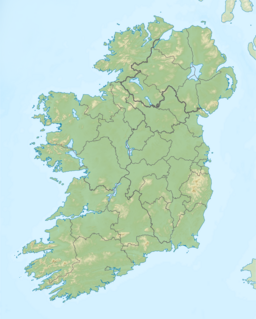History
Ironworks
Iron ore has been extracted at Slieve Anierin for millennia. From the early 17th century a number of mines and works were conveniently contiguous to Lough Allen, allowing for the transportation of iron ore over water to the ironworks in boats of up to forty tons. During the Irish Rebellion of 1641 nearly all ironworks were destroyed, but many were revived by the English after the Irish Confederate Wars. Extensive forests around Lough Allen before the 17th century were denuded to make charcoal for ironworks, the industry later collapsing in the 19th century.
Reservoir
On the construction of the Shannon hydroelectric scheme in 1925–9, the lake became a storage reservoir for the power station nearly 100 miles away, with sluices to control the flow into the river. This helps to maintain the flow during dry periods and manage flooding at other times. It made the Lough Allen Canal, which was rarely used by this time, unusable until restored in 1996. [17]
Regattas
In the mid-19th century, regattas were held by M. O'Conor at Lough Allen Island which is also known as O'Reilly's Island at the southern end of the lake. The house is destroyed, and only a ruin now exists. Regatta parties were held at Birchill's House, Blackrock. E.K. Tenison of Kilronan Castle, the photographer, Captain Tottenham, Captain Birchill and Francis la Touche attended the Regatta parties. Among the yachts competing in the regattas were 'Corsair', 'Avenger', 'Querida', 'Meta' and 'Shamrock'. [18] The Water Wags from Dun Laoghaire, organised a regatta on Lough Allen, in September 2015, for their 14'-3" long historic open clinker dinghies. competed in a regatta in 2014, including Penelope (1933), Scallywag, Swift, Moosmie (1910), Mollie, Chloe, Marie Louise (1927) and Good Hope. This was probably the first regatta on the lake since the mid-19th century. [19]
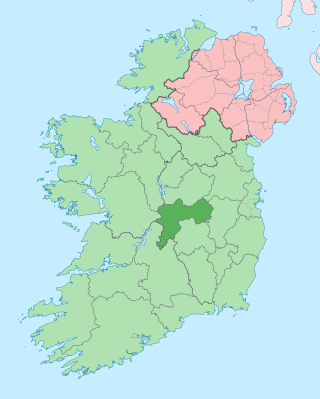
County Offaly is a county in Ireland. It is part of the Eastern and Midland Region and the province of Leinster. It is named after the ancient Kingdom of Uí Failghe. It was formerly known as King's County, in honour of Philip II of Spain. Offaly County Council is the local authority for the county. The county population was 82,668 at the 2022 census.

Drumshanbo is a small town situated in the heart of County Leitrim, Ireland. Drumshanbo is surrounded by a scenic area of soft rolling hills, woodlands, lakes and the Sliabh an Iarainn and Arigna mountains. It is a well preserved town with traditional pubs, shops, and restaurants.
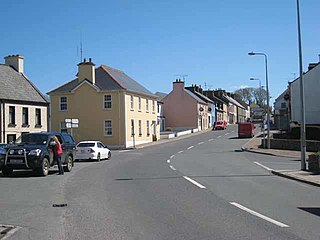
Drumkeeran is a village in County Leitrim, Ireland located at the junction of the R280 and R200 roads. It is situated in drumlin hills at the foot of Corry Mountain, just north of Lough Allen.

Lough Melvin is a lake in the northwest of the island of Ireland on the border between County Leitrim and County Fermanagh. It is internationally renowned for its unique range of plants and animals.

Lanesborough–Ballyleague, more commonly known simply as Lanesborough, is a town in the midlands of Ireland. Lanesborough is on the County Longford (east) side and Ballyleague on the County Roscommon (west) side of the River Shannon. They are located at the northern tip of Lough Ree on the N63 national secondary road at its junction with the R371 and R392. The town of Longford is 16 km north-east on the N63, the town of Roscommon is 15 km south-west on the N63, the town of Ballymahon is 20 km south-east on the R392 and the town of Strokestown is 15 km north-west on the R371.
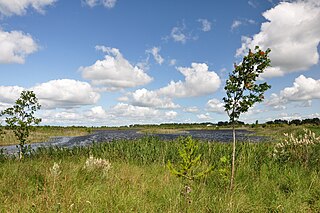
Boora Bog is a cutaway peat bog situated in County Offaly, Ireland. Peat was harvested for fuel between the 1950s and 1970s, and the land is now being reclaimed for agricultural and eco-tourism use. There was a lake called Lough Boora, which was drained by Bord na Móna, but was not used for peat production: this area is now maintained as a nature reserve by the Irish Wildlife Trust. There are two angling lakes.

Glencar Lough, locally known as Glencar Lake, is a freshwater lake in the northwest of Ireland. It covers an area of 1.15 square kilometres and lies mostly in County Leitrim with a smaller part in County Sligo. Glencar Waterfall is located near the lake's north shore on the Leitrim side.

Glenade Lough, locally known as Glenade Lake, is a freshwater lake in the northwest of Ireland. It is located in north County Leitrim in the Glenade Valley.

Garadice Lough (Irish: Loch Guth Ard Deas, also known as Garadice Lake or Lough Garadice, is a freshwater lake in County Leitrim, Ireland. It is located in the south of the county and now forms part of the Shannon–Erne Waterway.
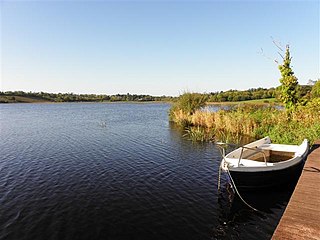
Lough Scur is a freshwater lake in south County Leitrim, northwest Ireland. It is part of the Shannon–Erne Waterway. There have been Human settlements here since the New Stone Age. Modern features include quays and moorings. Protected features are Castle John, three Crannogs, and the causeway into Rusheen Island, though "Jail Island" is not protected. The ecology of Lough Scur, and indeed all county Leitrim lakes, is threatened by pollution and invasive species such as curly waterweed, zebra mussel, and freshwater clam.
St. John's Lough, also known as St. John's Lake, is an irregularly shaped freshwater lake located in south County Leitrim, in northwest of Ireland. The lake forms part of the wider Shannon–Erne Waterway tourist attraction. The ecology of John's Lough, and the Shannon-system, is threatened by pollution and invasive species such as curly waterweed, zebra mussel, and freshwater clam.

Belhavel Lough is a freshwater lake in the northwest of Ireland. It is located in north County Leitrim near the village of Killarga.
Sliabh an Iarainn, anglicized Slieve Anierin, is a mountain in County Leitrim, Ireland. It rises to 585 metres (1,919 ft) and lies east of Lough Allen and northeast of Drumshanbo. Its present form evolved from the southwestward movement of ice age glaciers over millions of years, the morainic drift heaping thousands of drumlins in the surrounding lowlands. Historically there were many iron ore deposits and ironworks in the area. Irish mythology associates the mountain with the Tuatha Dé Danann, particularly the smith god Goibniu. Sliabh an Iarainn is an important natural heritage site with exposed marine and coastal fauna of paleontological interest

Rinn Lough, also known as Lough Rynn, is a freshwater lake in the northwest of Ireland. It is located in south County Leitrim.
Carrickaport lough is a freshwater lake in Kiltubrid parish, south County Leitrim, northwest Ireland. Drumcong village, and Lough Scur, lie nearby. Carrickaport lough is known for quality bream and pike fishing. The ecology of Carrickaport lough, and other Leitrim waterways, is threatened by curly waterweed, zebra mussel, and freshwater clam invasive species.
Keshcarrigan lough is a mesotrophic freshwater near Keshcarrigan village, in northwest Ireland. Known for quality coarse fishing, Keshcarrigan lough allows bank fishing from concrete stands on the northern shore, two with wheelchair access. The ecology of Keshcarrigan lough, and other Leitrim waterways, is threatened by curly waterweed, zebra mussel, and freshwater clam invasive species.

Castlefore Lough is a mesotrophic freshwater in northwest Ireland. Known for good coarse fishing, Castlefore Lough has limited bank fishing. The ecology of Castlefore Lough, and other Leitrim waterways, is threatened by curly waterweed, zebra mussel, and freshwater clam invasive species.
Lough Marrave is a small freshwater lake in county Leitrim in the northwest of Ireland.
Drumaleague Lough is a very small freshwater in northwest Ireland. The ecology of Drumaleague Lough, and other Leitrim waterways, remain threatened by zebra mussel and other invasive species.
Lough Conway is a very small freshwater lake in northwest Ireland.

